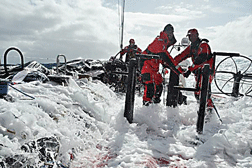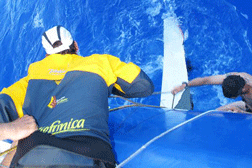
|
Volume 16, Issue 50 - December 11 - December 17, 2008
|
|
Columns |
Volvo, Leg 2: 4,450 Nautical Miles
from South Africa to India
Chesapeake waters are nothing like the Southern and Indians oceans
by Steve Carr
Chesapeake sailors may think we’ve got it tough with light and fluky winds, boat wakes, crab pots and line squalls. But you know you’re in another world when you have to worry about pirates. Welcome to Volvo World.
Pirates had just captured a Saudi super tanker filled with oil as the Volvo 70s were about to sail north into the Indian Ocean where the danger lay. To steer the boats away from Somalia, a scoring gate was put into play at longitudinal line 58 degrees. If they wanted to snag points, they had to sail far to the east before heading north toward their destination in Cochin, India.
Leg two of the Volvo Ocean Race began with the boats heading south, trying to pick up the screaming gales and giant seas rolling north from Antarctica while getting out of the wind shadow of the African continent.
East out of the Pirates’ Path
 |
Water cascades over the deck aboard Puma, top. Aboard Telefonica Blue, above, Iker Martinez helps Pepe Ribes as he cuts off the broken daggaboard. |
As the boats swung east, and into the teeth of the Southern Ocean’s Roaring 40s, all hell broke loose.
First, Green Dragon’s carbon boom snapped in half in the midst of a 50-knot squall in 30-foot seas.
Then Puma almost broke apart.
Ken Read, Puma’s beleaguered skipper, described it this way: “The proverbial you-know-what hit the fan when we got about as vertical in a sailboat as you ever want to be going down a big dark wave that sort of snuck up on us. Then, we found another beauty of a wave. This one was different than the other 10,872 smashes over the past 48 hours. This one caused several cracks in our longitudinal frames in the bow section. And for those laymen out there, these frames are the spine of the boat which don’t allow it to fold in half.”
Onboard Team Russia, skipper Andreas Hanakamp described the mayhem: “The boat slowed down almost to a standstill, up to the mast in solid green water. Then, everything went into slow motion. Not a violent knock down, but the boat slowly turning, heeling more and more to the wrong side, the boom high up in the air until coming over, and the kite flying around the forestay and flapping in the 35 knots of breeze.”
Telefonica Blue skipper Bouwe Bekking thought they had it easy just dealing with shredded sails and the crew laid low from drinking contaminated water. Then … “We were going so nicely, and all of a sudden a BIG BANG changed everything. We snapped off one of our daggerboards which prevent the boat from sliding sideways. Hammers, chisels, hacksaws, everything were out. And in the end we lowered Pepe [Ribes] in the water, to get rid of all the bits and pieces, so that we could lift the board up again.”
Ericsson 3’s media crewman Gustav Morin described their own nightmare. “Last night, in complete darkness, we had a quite dramatic broach. We were sailing in steady 30 knots and rough seas when a big squall came in. In just a few seconds the wind increased to over 40 knots. Bowman Anders Dahlsjo lost his grip and got smashed into a winch handle down to leeward. The handle bent badly and Anders was in agony, holding his hands over his ribs. Now we have one more guy on painkillers.”
Telephonica Black also snapped its daggerboard and followed the other wounded boats north while Ericsson 4 and her twin Ericsson 3 banged it east and were first and second to the scoring gate, followed by Green Dragon.
Due North
As the boats sailed due north into the warm and steady trade winds, it was time to heel and plot.
The equator is a hard place to navigate because it is a region of almost dead calm sprinkled with unpredictable storm cells. This part of the globe is referred to as the Doldrums. The Volvos had to deal with them heading south during the first leg in the Atlantic, when the boats that went to the west were the first to break its mind-numbing grip.
Skipper Read described their game plan. “We are active cloud chasers. Every cloud gets sized up and gets points. Find one of them to ride for an hour and you are looking good.”
 |
An Indian Ocean Rainbow from aboard Telefonica Black. |
The first to escape the dead air was lead boat Ericsson 4, vanishing into a black cloud of big wind. Ericsson 4 then hugged the Indian coastline, taking advantage of the Cochin Doctor sea breeze to finish in the darkness 14 days and a million mishaps after leaving sunny South Africa.
“The trip had a lot of very difficult conditions, cold and wet and the light Doldrums,” said winning skipper Torben Grael. “We had many breakdowns, but we got to the gate in a good position, and of course, we are very happy to be here in first place.”
The next day, cagey Volvo Skipper Bouwe Bekking steered Telephonica Blue across the finish line. She had been forced to go west because, without her starboard daggerboard, she would be pushed sideways to the east. That proved to be a blessing in disguise because, as in the Atlantic, the west run was where the wind was best.
The stress-filled battle for third was among Ericsson 3, Puma, Green Dragon, Delta Lloyd and Telephonica Black — never more than a few miles apart and often within view of one another after sailing 4,450 miles. In the end, it was the young bucks on Ericsson 3 who pulled it out — after having their radar unit ripped off the mast and leaving them running blind for the last 2,000 miles.
Ericsson 4 has solidified the lead with 26 points, followed by Telephonica Blue with 19 and the race’s upstart contender Puma with 18.
Next up: 1,950 miles to Singapore.